The Bundesliga top-four clash between Borussia Dortmund and RB Leipzig was played on Saturday, it was very good for Domenico Tedesco’s side as they beat their opponents 4-1, which might be slightly unexpected considering the hosts were placing second in the league. However, tactically, Leipzig were impressive because their pressing was well-drilled to limit the threat of the opponents. They were willing to give the ball to the opponents while using smart and clever pressing to trigger counter-attacks in the game.
This tactical analysis will explain how well did Leipzig manage to keep Dortmund’s threat minimal.
Lineups
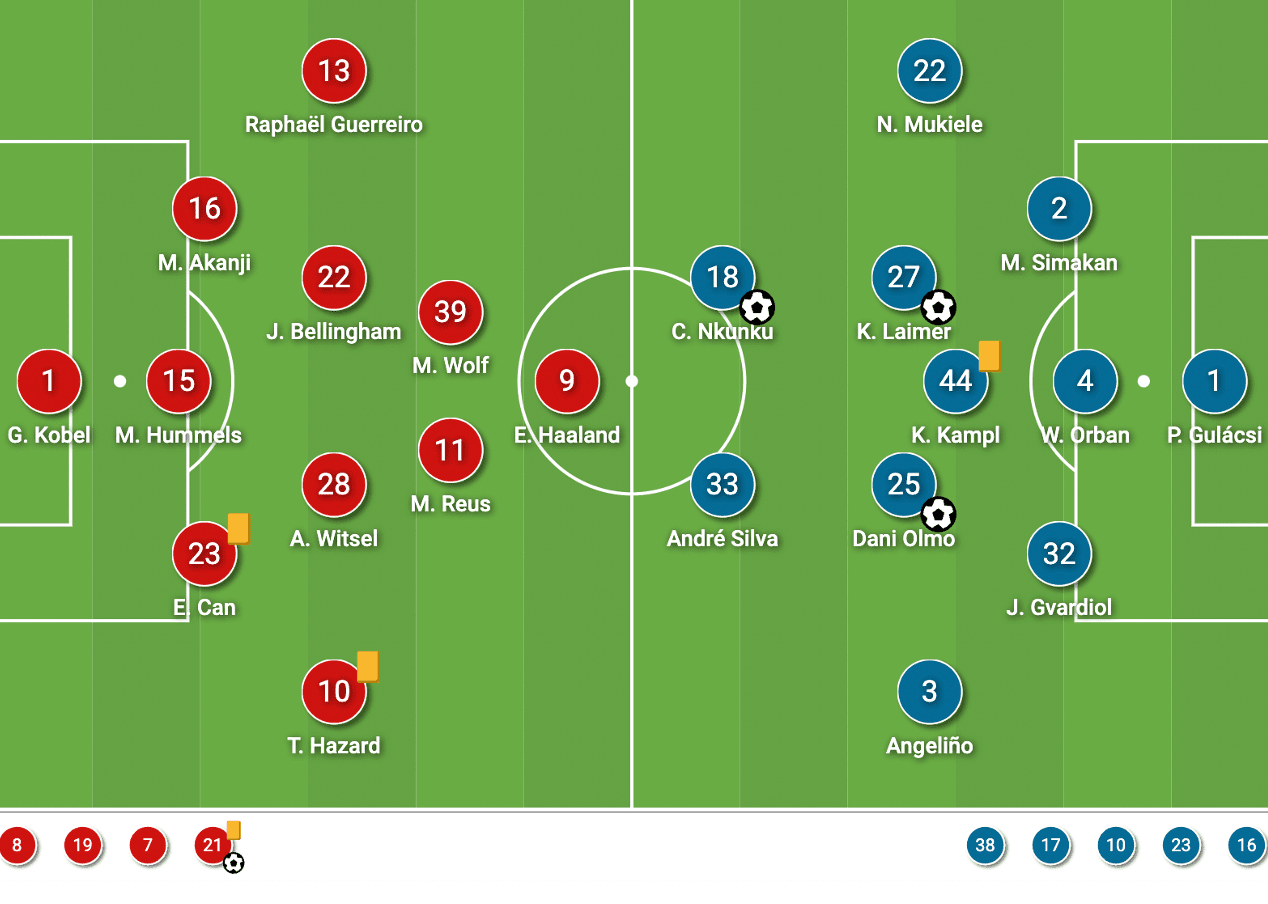
After an unsuccessful first half against Köln with a back four, in this game, Marco Rose went for a 3-4-2-1 formation. Marius Wolf was given a chance again to prove himself as he started ahead of Giovanni Reyna and Julian Brandt, he supported Erling Håland with Marco Reus. With a back three formed by Emre Can dropping into the right centre-back position, Rose might want to have more numbers in the centre but that was not effective in this game.
Leipzig were experiencing a small injury crisis in the midfield positions as both Tyler Adams and Amadou Haidara were unavailable for this game. Tedesco opted for a 5-3-2 formation which was slightly different from the 5-2-1-2 he used before – Dani Olmo was deployed as an 8 instead supporting the striker as a 10, and this minor tactical tweak achieved good strategical advantages to help the team without possession.
Careful Leipzig pressing
As we explained in the above, Leipzig’s shape was very different from the one they used as usual, this was not a 5-2-1-2 without possession, and the numbers did mean something.
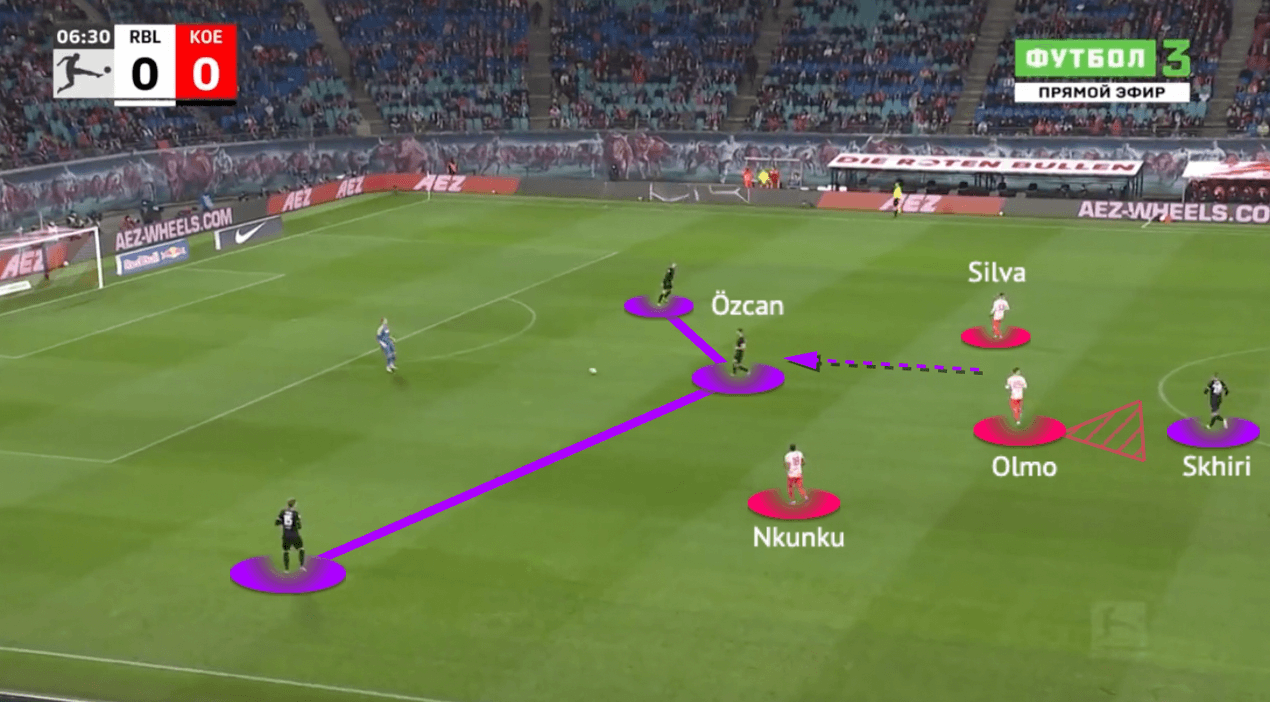
Let’s see how the 5-2-1-2 of Leipzig functioned before, although this game was slightly different as Köln was playing with a back four. However, Leipzig were pressing high on the pitch as the strikers could orient themselves towards the centre-backs. They could lead the press, being aggressive to jump to force the opposition to play. Meanwhile, the task to cover the opposition 6 was mostly Olmo’s job, as he was on Elles Skhiri in the above image.
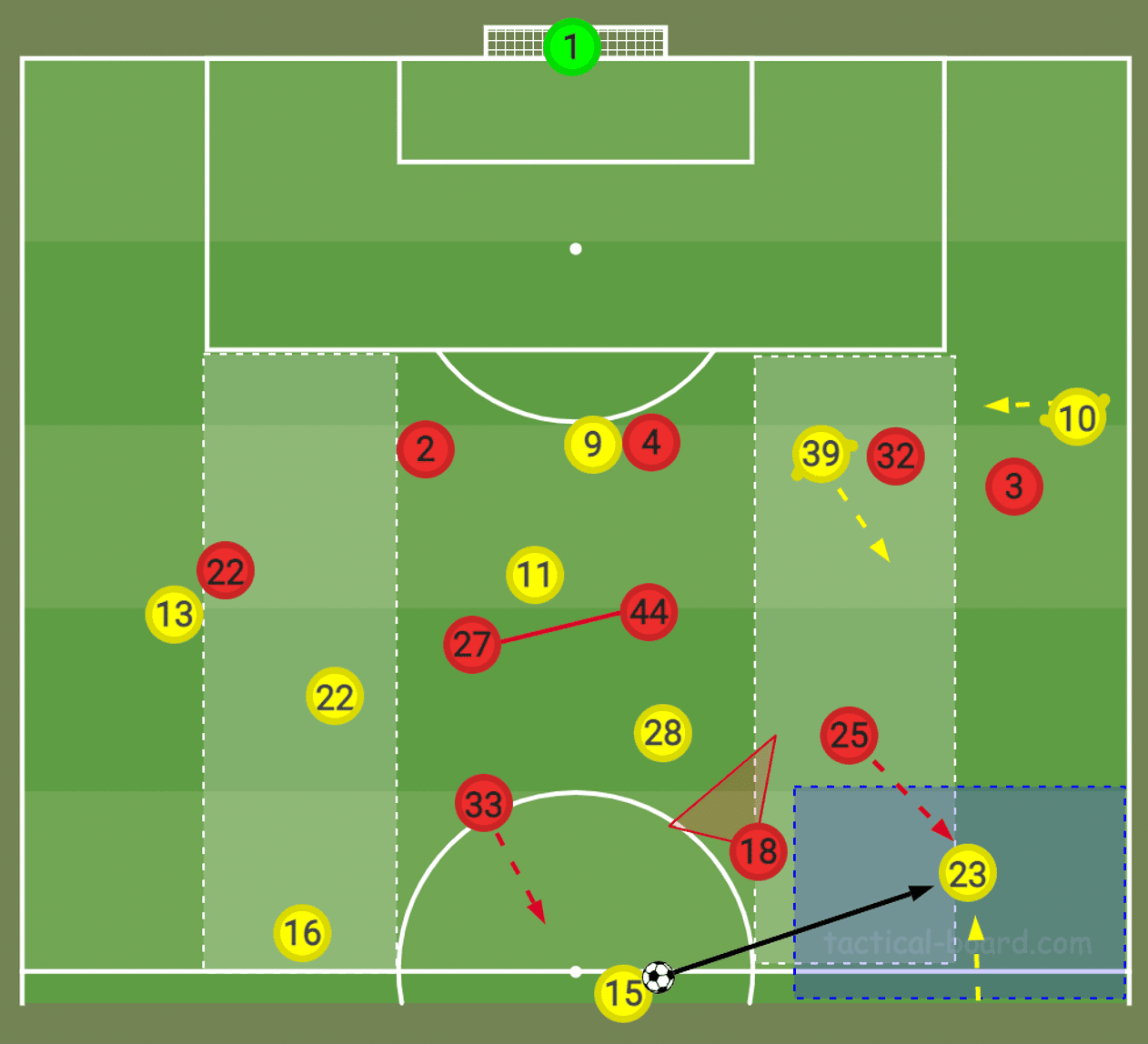
But against Dortmund, a stronger side with more quality in spaces behind, Tedesco decided to use a rather careful approach without possession. They lowered the engagement line and changed the shape to keep the lines more compact vertically, so the defensive organization was more controlled.
The above image outlines the 5-3-2 pressing of Leipzig and how it limited Dortmund’s attack. In this game, the strikers had a very clear duty, which was to limit Axel Witsel’s room to receive. That means they should not be too high to press the centre-backs, and rather be closer with the second line so Dortmund could not play inside them. On some occasions, Jude Bellingham was able to receive outside of the formation but Leipzig could respond by Konrad Laimer’s jumping out to press as well. Since the strikers were very disciplined, the 6 – Kevin Kampl could stay a bit deeper and that was important for him to minimize Marco Reus’ space, who liked to drop slightly from his position to play behind the midfield.
Meanwhile, Leipzig calculated the risk of letting Dortmund defenders have the ball. They were happy to let Can play given that the former Liverpool player could not threaten the defence. Can was also prone to commit individual errors, so it was like a trap when they lured Dortmund to go to Can and net them in the blue zone, by Olmo jumping out to press. When that happened, the ball near the striker should be patient and keep Witsel under his shadow, while the other striker, which is André Silva above, should jump out to press Matt Hummels so they cut the circulation flow of Dortmund’s attack.
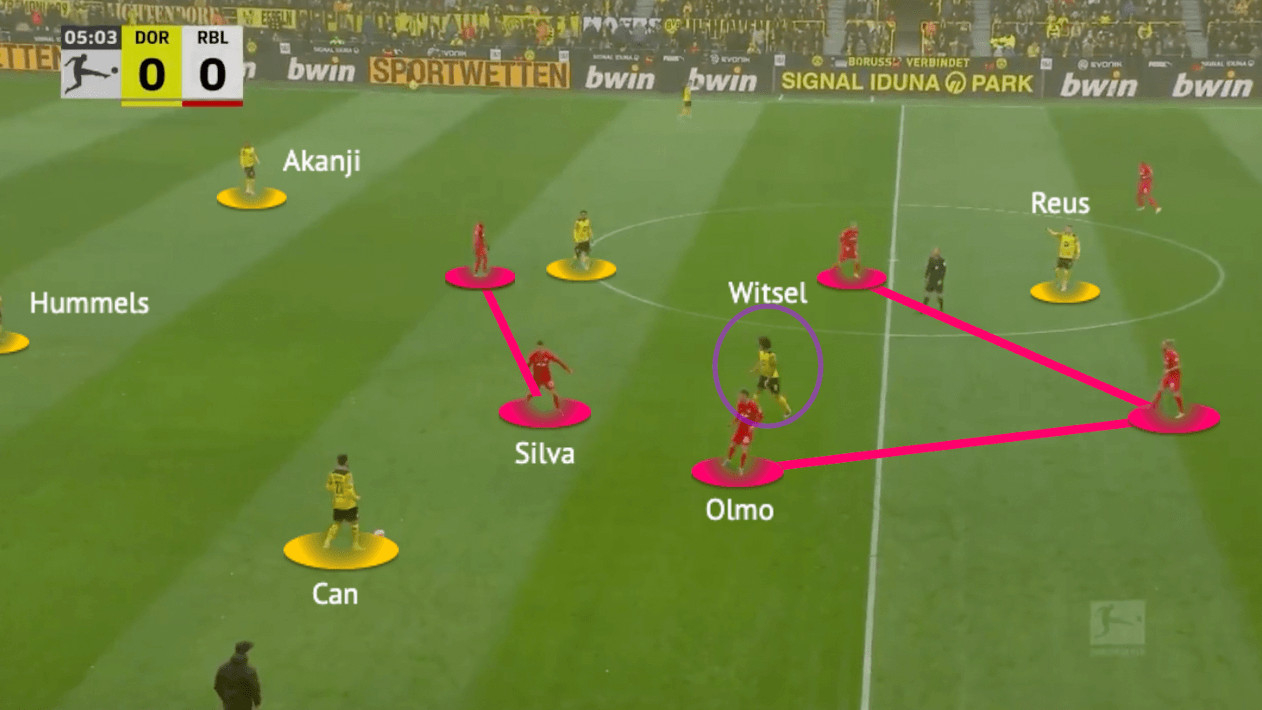
We have some game examples to illustrate the situations. Here, Dortmund looked like to use their 3v2 advantage in the first line as Can received, but they never really break the line because Leipzig strikers were deep. When Can received, the Leipzig communication was very clear – Silva knew he was going to cover Witsel, not jumping out to press, the outside and Olmo was clear about his job was to jump out to press Can.
The defensive shape of Leipzig could also be viewed as a 5-1-2-2 because Kampl was very important to stay deeper and cover the others. Also, Kampl must be alert to retrieve the second balls when Dortmund went for long.
On the other hand, since Bellingham was also in the centre in this scenario, so Christopher Nkunku was slightly deeper to cover him. But Nkunku would also be ready to press Manuel Akanji when Can wanted to go back, then, Laimer would step up to take Bellingham in the press.
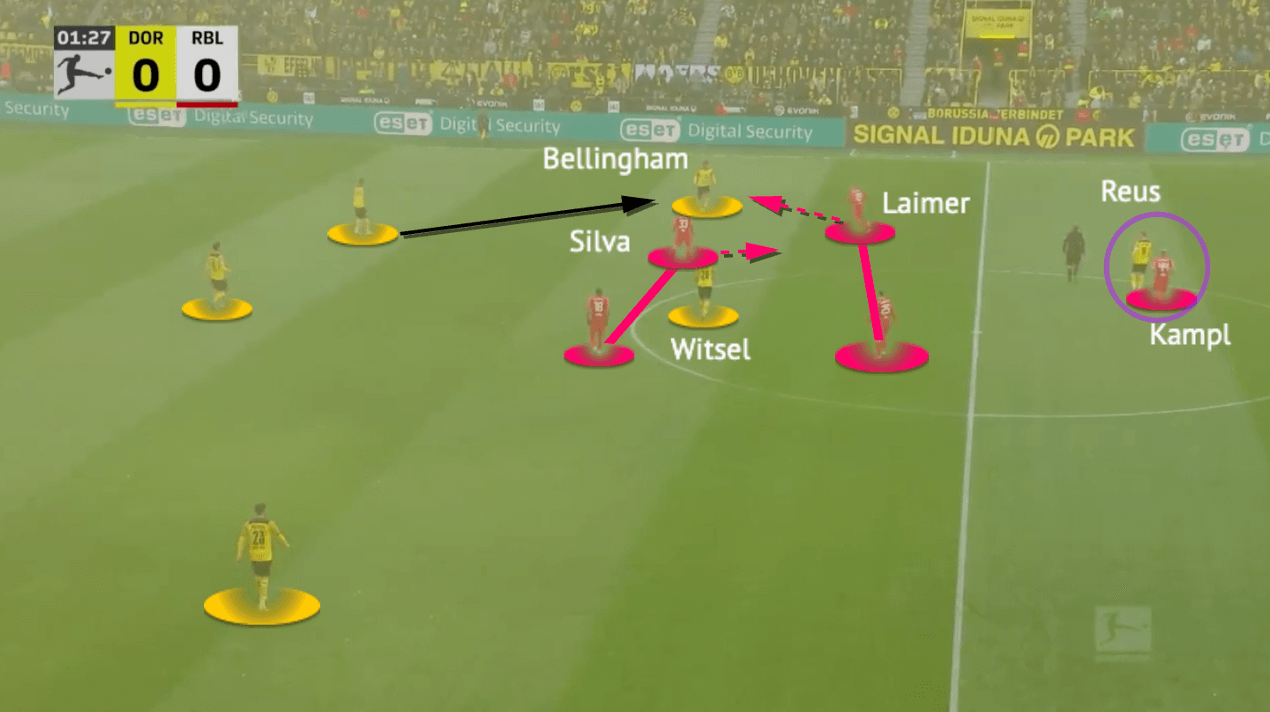
In this alternative scenario, it was a bit different as Bellingham received outside of the formation on the other side. But that would not be a trouble for Leipzig as Laimer could jump out to close the Englishman midfielder, while Silva retreated a bit to block the passing lane to Witsel, Dortmund were unable to progress further.
Also, since Kampl was deeper, so Reus is also under control when he roamed into midfield, Leipzig would not be caught in such a case.
Why Dortmund had minimal threat?
There are more examples about Leipzig’s pressing, but we also wanted to explain why Dortmund were unable to beat the press, so more details were explained in this section from the hosts’ perspective.
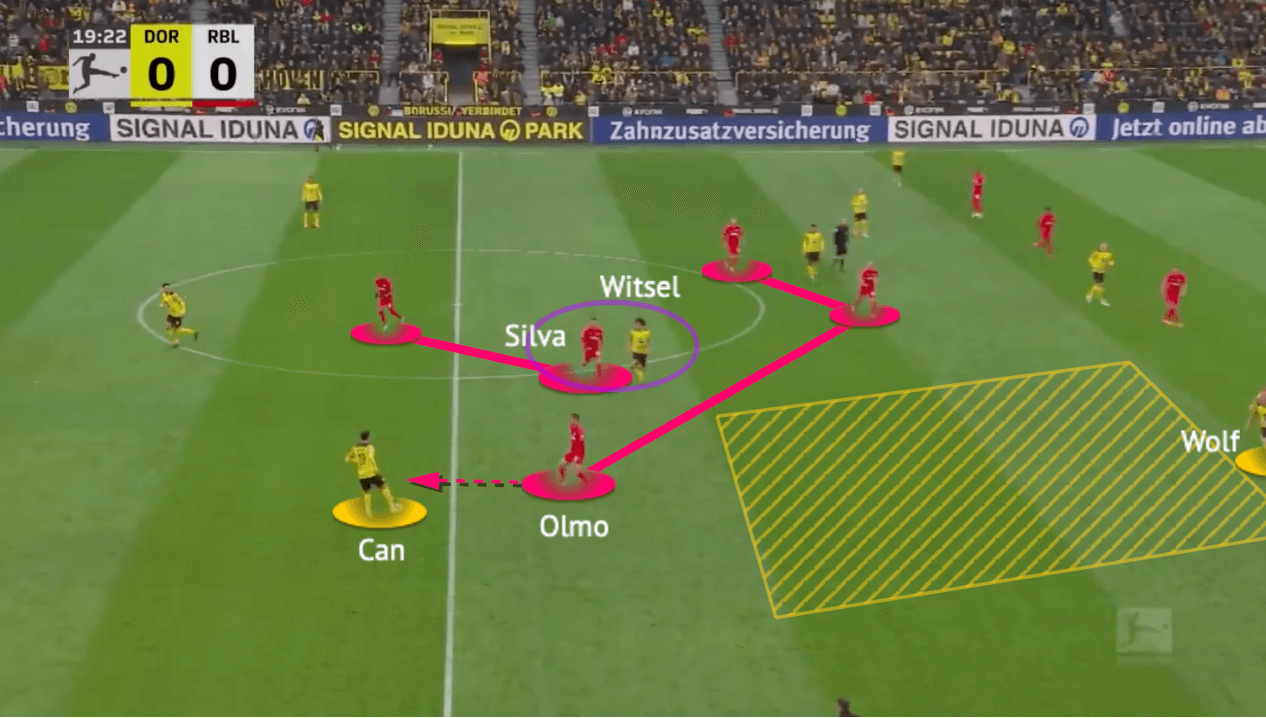
Here, again, when Dortmund were attacking with Can on the ball, Olmo was attacking him and Silva was covering Witsel as usual. These were explained and part of the game that Leipzig did well.
However, the players on Dortmund’s right side, Wolf, and Thorgan Hazard were not doing enough to create passing options for Can, that was another reason that the German defender had a terrible day. For example, the yellow zone was completely vacated in this scenario above as both Wolf and Hazard were high. Yes, they pinned Joško Gvardiol and Angeliño deep, but no one would be ready to receive in spaces.
As a result, Can had no choice and must go back if he did not kick the ball forward by speculation.
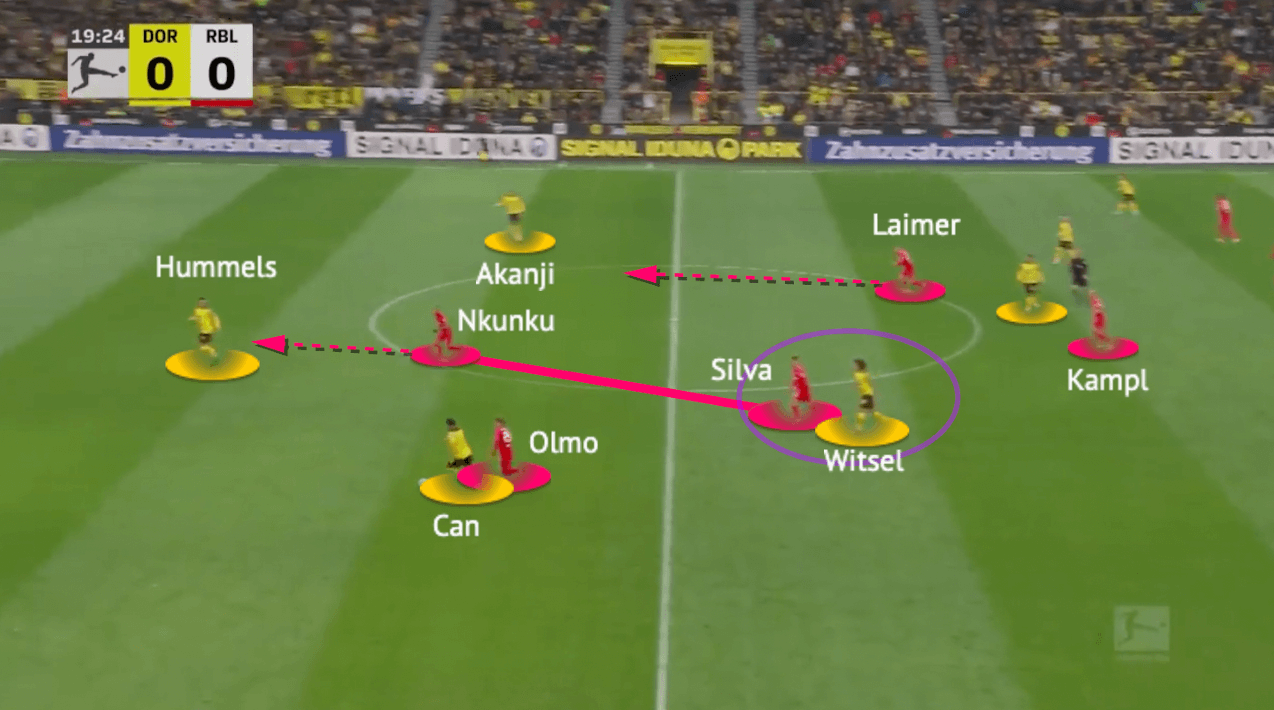
But when that Dortmund went back, Leipzig’s press ate them. Hardly could the hosts circulate the ball via the backline because Tedesco’s men jump out to press and cut the passing link very well.
In the next image as shown above, when Hummels was going to receive from Can, Nkunku jumped out to press again to make sure there was no time to play forward or open the angle to play laterally. But even Hummels managed to find Akanji, the same would happen again as Laimer was already moving higher for that pass. It did not happen, Hummels was forced to go back to the keeper, then Gregor Kobel just kicked the ball long and nothing developed from that.
Meanwhile, you could also see Silva was disciplined to stay with Witsel, and Kampl was on Reus to make sure Dortmund could not break inside them.
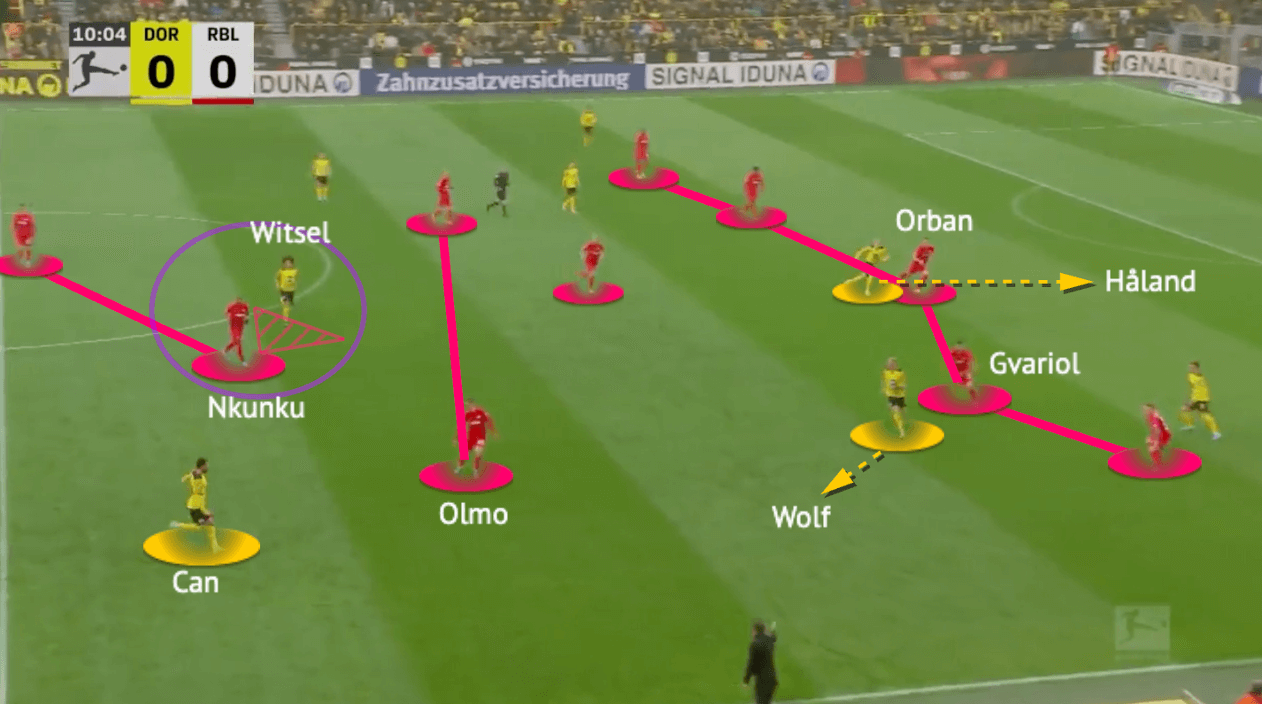
In addition, there were a lot of runs in behind from Dortmund front players, the likes of Håland were really good at that. However, those runs were always wrongly-timed and not angled enough to fit the player on the ball – these efforts were in vain, and they did not stretch the defensive line or create conditions for Dortmund to play vertically.
Here, we can see Hazard was almost in an offside position because he ran too early; Wolf dropped to offer a short option for Can, but he was never an ideal receiver because Gvardiol was very tight on marking him, and the body orientation of Wolf was usually closed. Although Wolf’s movement opened a gap between Willi Orbán and Gvardiol, which Håland could exploit with runs, the Norwegian striker was not quite connected by his teammate in this game. Can did not have the passing ability to send a quality ball behind. It was really difficult for Dortmund to create something from here.
Other parts of Leipzig’s defence were on the spot as shown in the above image, such as Nkunku covering Witsel, and Olmo jumping out to press Can.
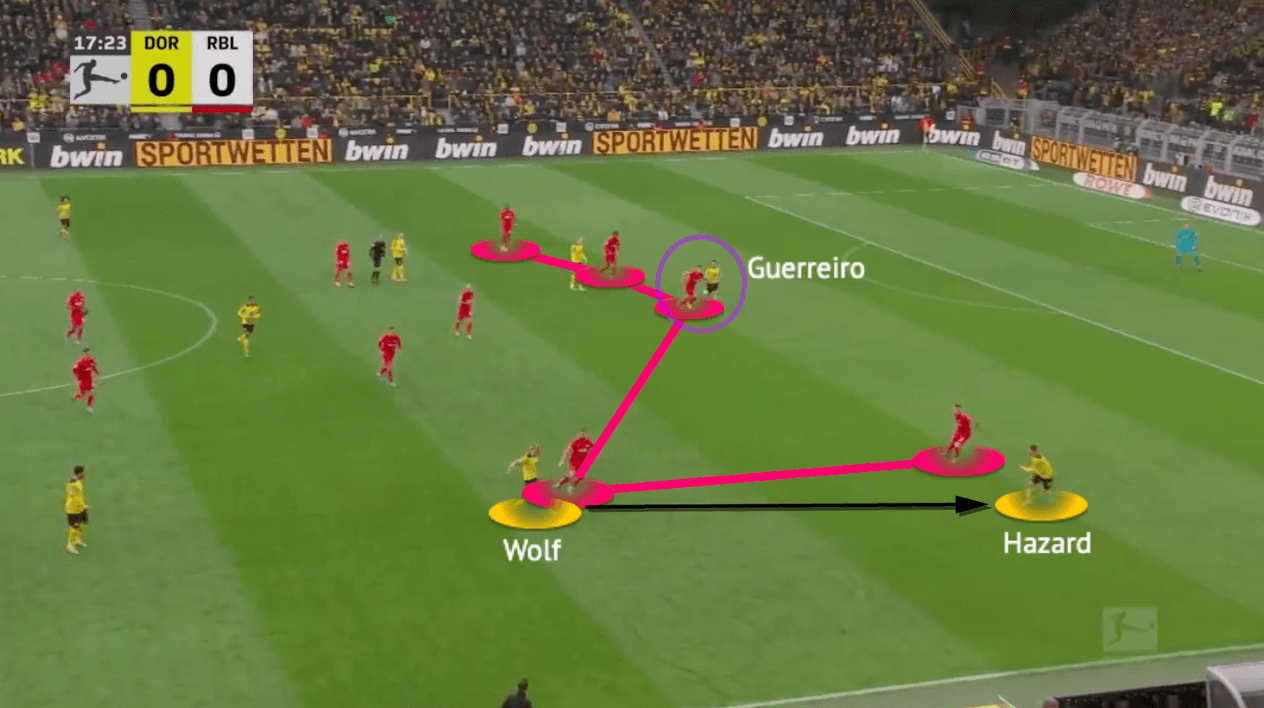
Another example of Dortmund players failing to connect with each other despite being able to stretch the gaps between the defenders. In the above image, Raphaël Guerreiro made the run too early and too vertical, so he could not reposition himself on time to make another effort to attack spaces behind Gvardiol.
Meanwhile, on the right side, Wolf did drop out to receive a bit deeper on this occasion, but Hazard on the same side also closed his body when supporting, which means even the Belgian international received, he had limited angle to play and the Wolf-Hazard duo barely had any threat on this flank.
The Dortmund changes barely helped
It was already 0-2 during the break, Leipzig had some luck in the second goal while the first goal from Laimer was a top-class finishing. Hence, Rose came with some changes and adjusted the team’s structure to pose other questions, but Leipzig were dealing with the new positions of Dortmund very well.
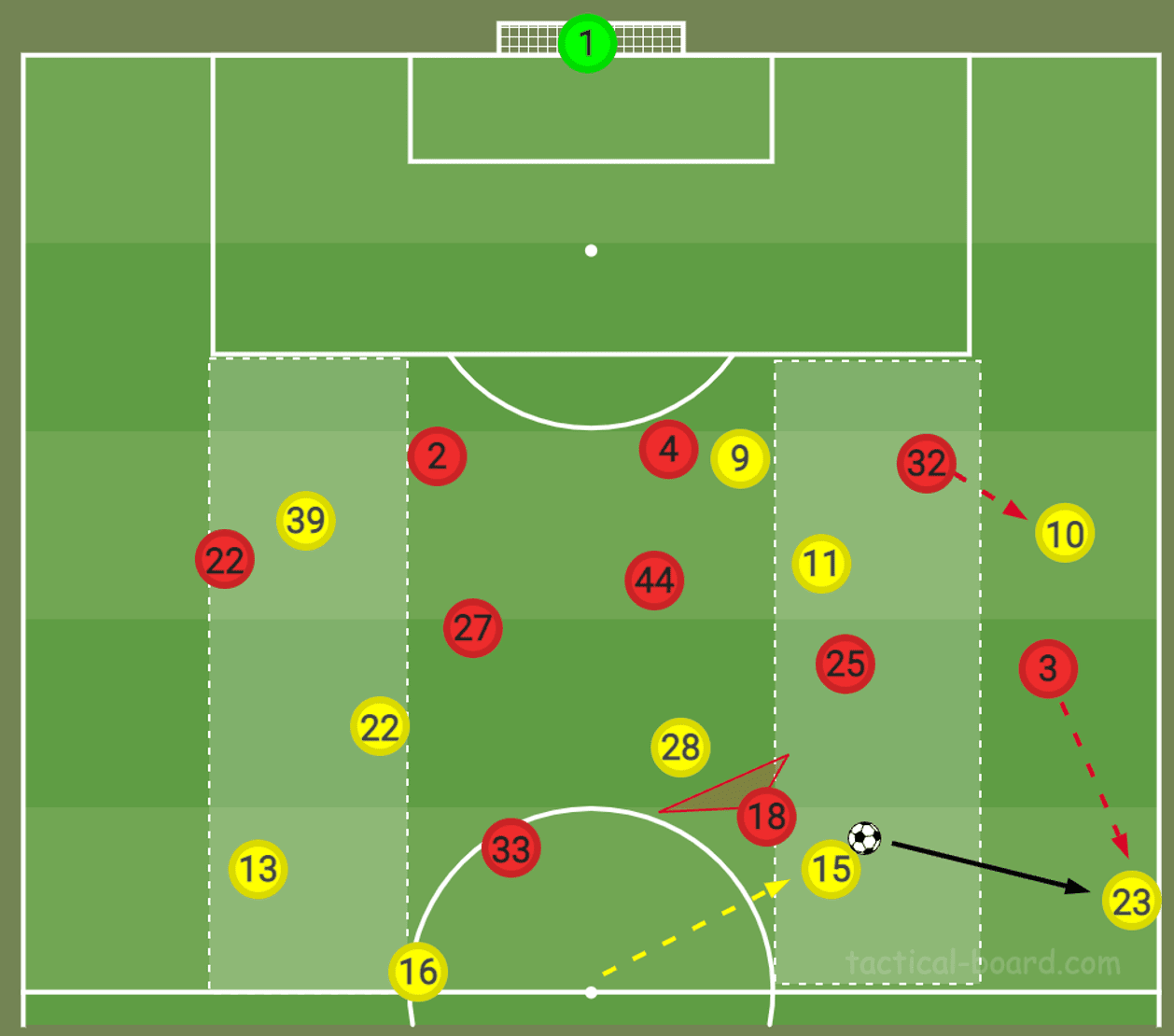
The above image shows how Dortmund were different compared to the first half, they moved to more like a back four with Can as the right-back. Guerreiro played deeper instead of going high. Reus and Wolf switched sides, as the skipper was now in the half-spaces, and behind Olmo to stop him from jumping out; Hazard was the right-winger.
But Dortmund’s changes were unable to solve Leipzig’s press either. Hummels struggled to find a passing option when he carried the ball forward. In the centre, Witsel was still covered by the striker, Rose amended that by playing Mahmoud Dahoud as the 6 to move in spaces but the impact was not obvious. While Can was wider, he was not offering a progressive option for the centre-backs, so whenever Hummels found him, it was a lateral pass that did not break any lines. That was a problem because Angeliño would come out to catch Can, then, it was the same with the first half as no further progressive option was offered.
Another reason was the disciplined Leipzig defence compressed spaces in the centre really well. Reus had a quiet game and rarely did harm in dangerous areas because there were the likes of Kampl and Orbán surrounding him.
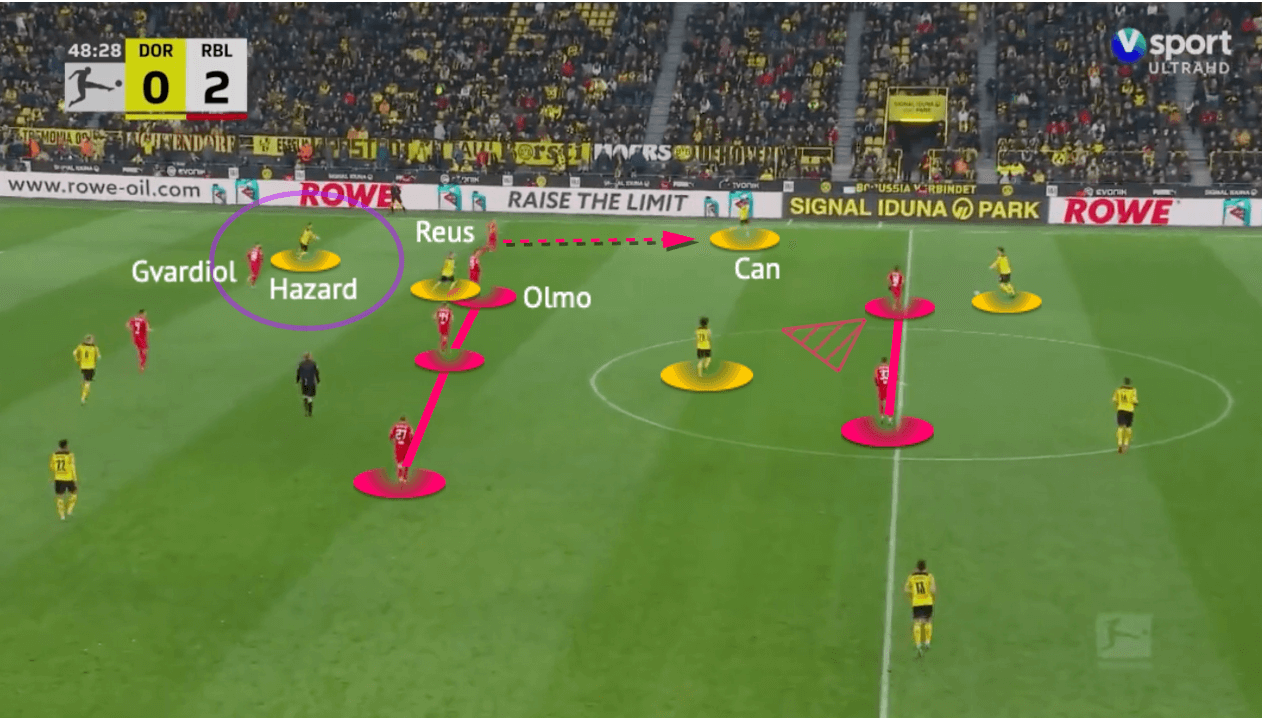
We can observe the changes via the above image. Here, Hummels had the ball and Can was a bit higher, between the first and second defensive line. But, Dortmund were still constrained to a larger extent as Nkunku was covering Witsel. While Reus’ position kept Olmo deeper and aligned with Kampl, it does not mean Can would be free because Angeliño could come out to close him. Then, even Hazard could roam and move a bit, Gvardiol was very alert to close the Belgian attacker, and now Hummels struggled to find a passing option because Akanji did not offer enough depth to receive the ball.
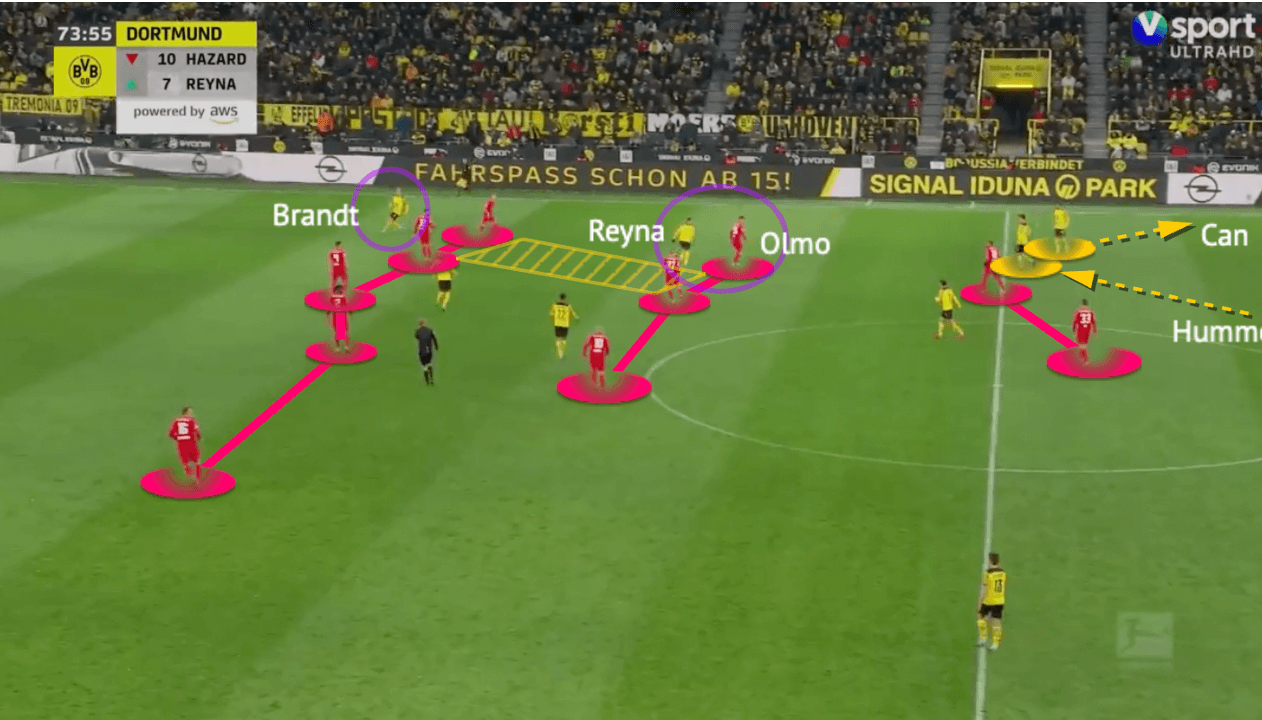
Another scenario here after Rose used the substitutes, but the situation was very similar. This time, Reyna was occupying Olmo deep, and Brandt was doing Hazard’s role in a higher position. Again, the run of Brandt was too early and did not impact the game enough, Leipzig were happy to use the offside line to nullify that effort.
While Hummels was carrying the ball forward, he faced the same dilemma here because Dahoud was under the shadow of Nkunku, and Can was backing off. There were no constructive options to help the team to create an attack, which was the condition Dortmund could not create throughout the game.
Conclusion
Of course, in terms of numbers, Dortmund were still in the title race, but in reality, it was too difficult to chase Bayern Munich as the gap between these two teams was big. It was a disappointing game for Rose and Rene Marić’s Dortmund as they let in some cheap goals, such as the second goal of Nkunku. They must be better prepared to play the key game against Bayern on 23/4.
This was a good result for Leipzig. Without the ball, as we described in detail in this analysis, they were quite good in pressing tactics and successfully disrupted the opponent’s rhythm. However, even though it was a 4-1 victory, it was not equivalent to perfect because Leipzig were not really good when they have the ball. As their xG 0.84 in this game suggested there was an overperformance, and there were a lot to work on to become a better side.





Comments